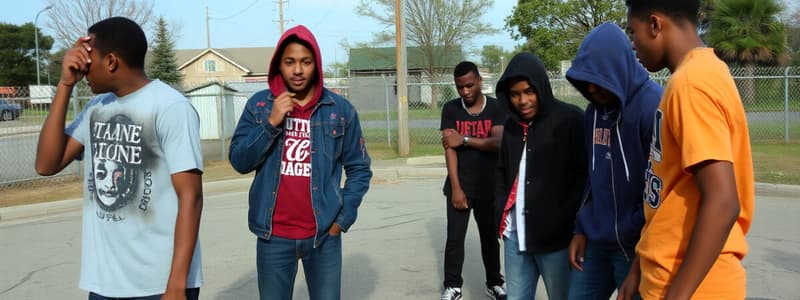Podcast
Questions and Answers
What does Thomas suggest as a major factor contributing to girls' delinquency?
What does Thomas suggest as a major factor contributing to girls' delinquency?
- Inadequate education systems
- Economic struggles
- Greater need for love (correct)
- Peer pressure
According to Otto Pollak, why are women considered to have a hidden form of criminality?
According to Otto Pollak, why are women considered to have a hidden form of criminality?
- They are given less opportunity to commit crimes
- They use their physiology to conceal their actions (correct)
- They have higher intelligence than men
- They are more physically capable than men
What reason does Pollak provide for women being instigators of crime?
What reason does Pollak provide for women being instigators of crime?
- They are more sensible than men
- They lack physical strength and have unique biological factors (correct)
- They experience more social freedom
- They possess higher levels of aggression
What concept is associated with Lombroso in relation to criminal women?
What concept is associated with Lombroso in relation to criminal women?
Which of the following claims does Thomas make about women’s problems?
Which of the following claims does Thomas make about women’s problems?
What is one consequence of moral panic as described in the content?
What is one consequence of moral panic as described in the content?
Which group was used as an example of youth deviance during the moral panic in the UK?
Which group was used as an example of youth deviance during the moral panic in the UK?
According to the content, which of the following is NOT a feature of moral panic?
According to the content, which of the following is NOT a feature of moral panic?
What cultural portrayal is linked to stereotypes of Black youth according to the content?
What cultural portrayal is linked to stereotypes of Black youth according to the content?
What term refers to individuals or groups that are depicted as threats to societal values during moral panic?
What term refers to individuals or groups that are depicted as threats to societal values during moral panic?
What is the primary principle regarding the severity of a sentence imposed on a young person compared to adults?
What is the primary principle regarding the severity of a sentence imposed on a young person compared to adults?
Which of the following is a principle regarding the consideration of similar sentences in the region for young offenders?
Which of the following is a principle regarding the consideration of similar sentences in the region for young offenders?
What does the principle of proportionality in sentencing state regarding the seriousness of the offense?
What does the principle of proportionality in sentencing state regarding the seriousness of the offense?
What should be considered before imposing a custodial sentence on a young person?
What should be considered before imposing a custodial sentence on a young person?
What is one of the potential objectives of a sentence under youth justice principles?
What is one of the potential objectives of a sentence under youth justice principles?
What is the primary goal of diversionary measures for youth offenders?
What is the primary goal of diversionary measures for youth offenders?
What is a common benefit of using diversionary measures?
What is a common benefit of using diversionary measures?
What is the most common type of extrajudicial sanction imposed on youth?
What is the most common type of extrajudicial sanction imposed on youth?
What must be true for a youth to be eligible for extrajudicial sanctions?
What must be true for a youth to be eligible for extrajudicial sanctions?
How long are records of extrajudicial sanctions kept before they are destroyed?
How long are records of extrajudicial sanctions kept before they are destroyed?
What is an effective strategy for younger offenders to learn their lessons?
What is an effective strategy for younger offenders to learn their lessons?
Why is restorative justice often preferred for informal measures?
Why is restorative justice often preferred for informal measures?
Which of the following reflects a key principle behind the police's approach to youth offenders?
Which of the following reflects a key principle behind the police's approach to youth offenders?
Which factor indicates a young person's difficulty in managing violent behavior?
Which factor indicates a young person's difficulty in managing violent behavior?
What type of evidence may suggest that a young person is likely to commit a violent offence before the expiry of their youth sentence?
What type of evidence may suggest that a young person is likely to commit a violent offence before the expiry of their youth sentence?
Which of the following best describes a situation involving the use of weapons in violent offences?
Which of the following best describes a situation involving the use of weapons in violent offences?
What is one potential benefit of serving a part of a youth sentence in the community?
What is one potential benefit of serving a part of a youth sentence in the community?
Which factor might be considered when assessing risks related to a young person's violent behaviour?
Which factor might be considered when assessing risks related to a young person's violent behaviour?
Which of the following elements is related to planning a serious violent offence by a young person?
Which of the following elements is related to planning a serious violent offence by a young person?
What role does community supervision play in relation to young offenders?
What role does community supervision play in relation to young offenders?
What is one characteristic associated with behaviour of a brutal nature in young offenders?
What is one characteristic associated with behaviour of a brutal nature in young offenders?
What is the maximum duration for probation under the Youth Criminal Justice Act for youth?
What is the maximum duration for probation under the Youth Criminal Justice Act for youth?
Which of the following is NOT a mandatory condition of probation under the Youth Criminal Justice Act?
Which of the following is NOT a mandatory condition of probation under the Youth Criminal Justice Act?
What does Section 3(1)(b) of the Youth Criminal Justice Act emphasize regarding young persons?
What does Section 3(1)(b) of the Youth Criminal Justice Act emphasize regarding young persons?
Which of the following is a characteristic of boot camps in the United States?
Which of the following is a characteristic of boot camps in the United States?
What is the primary goal of implementing boot camps for youth offenders?
What is the primary goal of implementing boot camps for youth offenders?
What condition is specifically prohibited under Youth Criminal Justice Act probation?
What condition is specifically prohibited under Youth Criminal Justice Act probation?
What is a common misconception about the effectiveness of boot camps?
What is a common misconception about the effectiveness of boot camps?
Which of the following defines deferred custody and supervision?
Which of the following defines deferred custody and supervision?
Flashcards
Thomas' Theory of Female Delinquency
Thomas' Theory of Female Delinquency
The idea that women's biological differences, like their need for love, make them more susceptible to delinquency. They use their sexuality to fulfill other needs.
Pollak's Theory of Female Criminality
Pollak's Theory of Female Criminality
The belief that women's biology, including their lack of a penis and menstruation, makes them more prone to deceit and manipulation, playing a role in criminal behavior.
Biological Positivism
Biological Positivism
A school of thought that posits biological factors, such as physical characteristics, influence criminal behavior.
Biological Positivism: Evolutionary Argument
Biological Positivism: Evolutionary Argument
Signup and view all the flashcards
Criminal Women: Biological Positivism
Criminal Women: Biological Positivism
Signup and view all the flashcards
Moral Panic
Moral Panic
Signup and view all the flashcards
Folk Devils
Folk Devils
Signup and view all the flashcards
Deviance Amplification
Deviance Amplification
Signup and view all the flashcards
Rapid Social Change
Rapid Social Change
Signup and view all the flashcards
Race and Moral Panic
Race and Moral Panic
Signup and view all the flashcards
Youth Sentence Proportionality
Youth Sentence Proportionality
Signup and view all the flashcards
Regional Consistency in Youth Sentencing
Regional Consistency in Youth Sentencing
Signup and view all the flashcards
Proportionality to Offense and Responsibility
Proportionality to Offense and Responsibility
Signup and view all the flashcards
Preference for Non-Custodial Sentences
Preference for Non-Custodial Sentences
Signup and view all the flashcards
Least Restrictive Sentence for Youth
Least Restrictive Sentence for Youth
Signup and view all the flashcards
Pattern of Persistent Violent Behavior
Pattern of Persistent Violent Behavior
Signup and view all the flashcards
Psychiatric or Psychological Evidence of Potential Violence
Psychiatric or Psychological Evidence of Potential Violence
Signup and view all the flashcards
Reliable Information About Planned Violence
Reliable Information About Planned Violence
Signup and view all the flashcards
Availability of Community Supervision Programs
Availability of Community Supervision Programs
Signup and view all the flashcards
Likelihood of Reoffending
Likelihood of Reoffending
Signup and view all the flashcards
History of Violence While Under Supervision
History of Violence While Under Supervision
Signup and view all the flashcards
Peacemaking Circles
Peacemaking Circles
Signup and view all the flashcards
Section 3(1)(b) of the Youth Criminal Justice Act
Section 3(1)(b) of the Youth Criminal Justice Act
Signup and view all the flashcards
Probation
Probation
Signup and view all the flashcards
Mandatory Probation Conditions
Mandatory Probation Conditions
Signup and view all the flashcards
Additional Probation Conditions
Additional Probation Conditions
Signup and view all the flashcards
Boot Camps
Boot Camps
Signup and view all the flashcards
Recidivism
Recidivism
Signup and view all the flashcards
Deferred Custody and Supervision
Deferred Custody and Supervision
Signup and view all the flashcards
Treatment Order/Intensive Support and Supervision
Treatment Order/Intensive Support and Supervision
Signup and view all the flashcards
Diversionary Measures
Diversionary Measures
Signup and view all the flashcards
Restorative Justice
Restorative Justice
Signup and view all the flashcards
Extrajudicial Sanctions (ES)
Extrajudicial Sanctions (ES)
Signup and view all the flashcards
Extrajudicial Sanctions Process
Extrajudicial Sanctions Process
Signup and view all the flashcards
Eligibility for Extrajudicial Sanctions
Eligibility for Extrajudicial Sanctions
Signup and view all the flashcards
Underlying Circumstances for ES
Underlying Circumstances for ES
Signup and view all the flashcards
Two-Year Rule for ES Records
Two-Year Rule for ES Records
Signup and view all the flashcards
Police Culture and Young Offenders
Police Culture and Young Offenders
Signup and view all the flashcards
Study Notes
CC200 Final Exam Review
- Format: 23 True/False questions, 52 multiple choice questions, 1 short answer question (2 options from week 12). Total of 80 marks, 30% of final grade.
- Yellow highlighted text: Requires additional information.
- Short answer questions: Likely to be in point form.
- Week 6 (17 Questions): Focuses on Friends and Gangs.
- Friends: Criminal behaviour is learned through group affiliations. Boys and girls are "differentially exposed" and "differentially affected" by criminogenic conditions, leading to gender gaps in youth crime rates. Girls are less likely to have delinquent friends than boys.
- Gangs: Gang levels are categorized.
- Level 1: Fluid friendship groups, unplanned criminal activity, no leadership, no name, signs or symbols.
- Level 2: Planned criminal activity (over a year), no leadership structure.
- Week 7 (9 Questions): Focuses on Media.
- Media: Describes how youth crime is portrayed in various media outlets, and related social issues.
- Week 7 (Moral Panic): Media amplification of youth deviance.
- Cohen (1972): Media presents a group or person in a stylised and stereotypical fashion to imply society's threats.
- Mods/Rockers (Example): Media hype amplifies a conflict between two youth subcultures to represent a broader threat.
- Week 7 (Films/Stereotypes): Focuses on how minority groups are portrayed.
- Race/Ethnicity (Giroux, 2002): Certain stereotypes depict a negative portrayal of youth.
- Week 8 (Biological Positivism): Explores perspectives on youth crime that consider biological factors as determinants of behaviour.
- Lombroso & Ferrero (1985): Female criminals are considered lower on the evolutionary scale than non-criminal females—and women as a whole are positioned at a lower evolutionary stage compared to men.
- Freud: Suggests promiscuous sexual behaviour is a response to issues with social development in girls.
- W.I. Thomas: Proposes that females need love to fulfill “basic needs” to avoid undesirable outcomes.
- Week 8 (Chivalry Hypothesis): Argues that women and girls are less likely to be considered criminals due to societal biases against men.
- Otto (Author): Women offenders of certain types (white, middle class) are treated more leniently than others.
- Week 8 (Power-Control Theory): Explains the differences in delinquency between genders based on family structures.
- Week 9 (Bullying): Discusses bullying based on gender and other distinctions.
- Week 10 (Policing Youth): Examination of Policing for different types of youth.
- Week 11 (Youth Court): Examines the Canadian youth court system.
- Specific crime outcomes and conviction rates.
- Week 11 (Legal Rights): Examination of legal rights from the YCJA perspective, specifically for youth.
- Differences between factual and legal guilt are explored.
- Week 12 (Sentencing Options): Detailed look at various sentencing options.
- Probation: Mandatory conditions, additional conditions, etc.
- Week 12 (Corrections): Analysis of corrections and rehabilitation resources.
- Week 12 (Sentencing Options): The article lists various sentencing choices, such as diversionary measures, fines, and custody.
- Week 13 (Restorative Justice): An alternative approach to settling conflicts with principles of accountability, respect and healing in communities.
- Week 13 (New Issues): Examination of concerns relevant to youth legal systems.
- Page 34 (Parental Rights): Parental rights/support systems are not comprehensive to support parents in handling their youth who need help. Issues arising from crossed over from welfare/foster care to criminal justice systems.
Studying That Suits You
Use AI to generate personalized quizzes and flashcards to suit your learning preferences.



